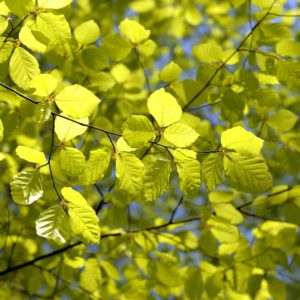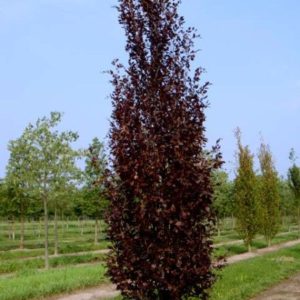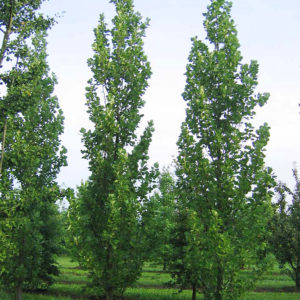Fagus sylvatica Dawyck Green
Price range: €210.00 through €620.00
Frequently Bought Together



Description
Quick Facts
- Common Name: Dawyck Green Beech, Fastigiate Beech, Columnar Beech
- Botanical Name: Fagus sylvatica ‘Dawyck Green’
- Plant Type: Deciduous tree
- Mature Height: 15-20m
- Mature Spread: 4-6m
- Flowering Period: April to May
- Flower Colour: Insignificant greenish flowers
- Foliage: Ovate leaves, bright green in spring maturing to mid-green, turning golden-bronze in autumn, often retained through winter
- Hardiness: RHS H7 (very hardy)
- Soil Requirements: Moist, well-drained, tolerates most soil types including chalk
- Aspect: Full sun to partial shade
- Maintenance: Low
Description
Experience the majestic elegance of Fagus sylvatica ‘Dawyck Green’, the spectacular Columnar Beech that brings exceptional architectural presence, space-efficient vertical form, and timeless beauty with its naturally narrow habit and classic beech character. This outstanding ornamental beech offers remarkable qualities—a naturally narrow, strongly upright columnar form that remains exceptionally compact, reaching only 4-6m wide even at maturity whilst growing 15-20m tall, making this perfect for restricted spaces, avenues, and formal plantings where traditional beeches would be far too wide, beautiful bright green spring foliage that emerges in fresh lime-green before maturing to rich mid-green creating a dense column of colour throughout summer, spectacular golden-bronze autumn colour that often persists through winter providing year-round interest, and exceptional hardiness, longevity, and adaptability to a wide range of conditions including chalk soils, making this one of the finest and most versatile columnar trees for creating dramatic vertical accent, formal structure, and enduring beauty in gardens, estates, and landscapes.
Throughout spring and summer, this captivating tree displays its characteristic ovate beech leaves measuring 6-10cm long with wavy edges and prominent parallel veins. The leaves emerge in spring in the most beautiful fresh lime-green with silky hairs, creating a luminous display that signals the arrival of spring. As they mature, the leaves develop into rich mid-green with a slightly glossy finish, creating dense, handsome foliage throughout the growing season. The naturally narrow, strongly upright branching creates a distinctive columnar silhouette that remains remarkably compact and formal without any pruning—a true pillar of green throughout summer. In spring, insignificant small greenish flowers appear but are largely unnoticed. In autumn, the foliage transforms into beautiful shades of golden-bronze, russet, and copper—and here’s the magic: like all beeches, many of the leaves persist on the branches well into winter (marcescence), providing continued colour and movement when most trees are bare. The smooth silver-grey bark is beautiful year-round, becoming slightly fissured with age.
This remarkable cultivar originated as a sport (natural mutation) discovered at Dawyck House in the Scottish Borders in the 1860s, hence the name ‘Dawyck’. It has been a cherished garden tree ever since, valued for its exceptional narrow form and reliable performance. Exceptionally hardy and adaptable, this beech thrives in Irish conditions, tolerating exposure, urban pollution, a wide range of soil types including chalk and alkaline soils (unlike many trees), and even coastal conditions. The narrow columnar form makes this ideal for situations where the grandeur and longevity of a beech is desired but space is limited—bringing beech majesty to medium-sized gardens, avenues, and urban settings. More tolerant of shallow soils over chalk than most large trees.
Create stunning compositions by planting as magnificent avenue trees where the uniform columnar habit creates dramatic formal impact—perfect for driveways, pathways, or street plantings where traditional beeches would be too wide. Exceptional as vertical accent specimens in gardens, estates, or formal landscapes where height and architectural presence are desired without excessive width. Works beautifully flanking entrances, framing buildings, or creating formal allées. Magnificent in rows for contemporary formal designs or as bold focal points in mixed borders. The narrow form makes this ideal for urban gardens, courtyards, or restricted spaces. Plant where the smooth silver-grey bark and russet winter foliage can be appreciated year-round.
Caragh Garden Notebook
Planting: Space trees 5-6m apart for avenue plantings to allow the narrow crowns to just touch at maturity, or allow 6-8m for specimen placement. Plant bare-root trees from November to March, or container-grown specimens year-round (autumn or early spring is ideal). Dig holes twice the width of the root ball and incorporate organic matter. Plant at the same depth as the nursery soil mark—avoid planting too deeply. Stake securely for the first 3-5 years. Water thoroughly and mulch around the base, keeping mulch away from the trunk. Choose positions with good air circulation.
Soil Preparation: Thrives in moist, well-drained soil with pH 6.0-8.0. Tolerates a remarkably wide range of soil types including clay, loam, sand, chalk, and moderately acidic to alkaline conditions—one of the few large trees that thrives on chalk. Prefers deep, moisture-retentive, fertile conditions but adapts well to poorer soils. Dislikes waterlogged or very dry soils. Tolerates urban pollution and exposure better than most trees. Best growth and colour occur in full sun to partial shade with consistent moisture, though very adaptable once established.
Container Growing: Not suitable for long-term container growing due to size, vigorous growth, and extensive root system. Young specimens can be grown temporarily in very large containers (minimum 80cm diameter) using soil-based compost for 2-3 years, but should be planted out for best long-term health, characteristic columnar form development, and the majestic stature that makes this tree so special.
Seasonal Care: Requires minimal to no pruning—the naturally narrow, upright columnar form develops perfectly without intervention. Remove only dead, damaged, or diseased branches in late winter when dormant. Never top or heavily prune as this destroys the characteristic columnar form and can lead to weak growth. Avoid pruning in spring when sap is rising. Apply slow-release balanced fertiliser in early spring if desired, though beeches are generally undemanding. Mulch annually with organic matter. Water during dry spells in the first 5-7 years until established—drought-tolerant once mature. Generally pest and disease resistant, though can be affected by beech bark disease in some areas.
Propagation: Cannot be propagated from seed as this is a selected cultivar that will not come true from seed and will revert to the spreading form of common beech. Professional propagation is by grafting onto Fagus sylvatica rootstock in winter. Budding in summer is also used commercially. Home gardeners should purchase nursery-grown grafted specimens for guaranteed quality, reliable narrow columnar form, and characteristic growth habit.
This majestic beauty is absolutely magnificent—that naturally narrow, upright columnar form brings all the grandeur and longevity of a beech to spaces where traditional beeches would never fit! The fresh lime-green spring foliage is gorgeous, and that golden-bronze autumn colour that persists through winter provides year-round interest. Smooth silver-grey bark, exceptionally hardy, tolerates chalk soils brilliantly, and lives for generations. Beech majesty in a space-efficient package—pure elegance!





